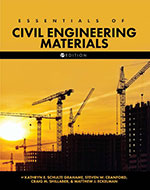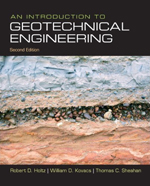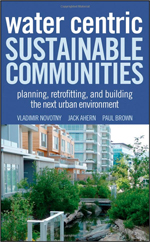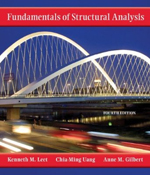“Industrial Ecology and Sustainability”
Authors: Thomas E Graedel and Matthew J Eckelman (CEE Associate Professor) – July 7, 2023
Description: Technology today is undergoing a rapid, unprecedented, and accelerating period of transformation. The implications of climate change, underpinned by geopolitics, for scientists and engineers are profound, as they and their societies attempt to harness these new technologies to address critical global environmental challenges, often without a full understanding of the long-term consequences. This textbook is designed to fill the gaps at a time of rapid changes in technology and the global environmental to develop sustainability situations. |
“An Introduction to Geotechnical Engineering (3rd Edition)”
Authors: Robert D. Holtz, Williams D. Kovacs and Thomas Sheahan (CEE Professor and Senior Vice Provost for Curriculum and Programs) – 6/15/22
Description: This new edition addresses a frequent request from students, faculty, and practitioners for a textbook that covers both the fundamentals of soil mechanics and soil properties, and also the basics of foundation engineering. As with the previous two editions, this new edition covers the fundamentals of soil and rock behavior required by geotechnical engineers for the design and construction of foundations, embankments, earth retaining structures, and underground works. |
“Sensor Technologies for Civil Infrastructures (2nd Edition)”
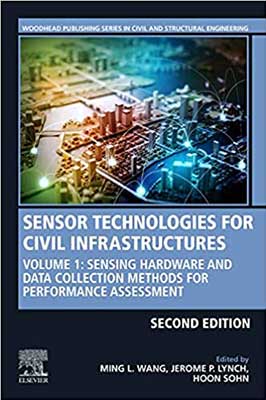  Editors: Jerome Lynch, Hoon Sohn, Ming Wang (COE Distinguished Professor) – 7/2022
Description: Sensor Technologies for Civil Infrastructure, Volume 1: Sensing Hardware and Data Collection Methods for Performance Assessment, Second Edition, provides an overview of sensor hardware and its use in data collection. The first chapters provide an introduction to sensing for structural performance assessment and health monitoring, and an overview of commonly used sensors and their data acquisition systems. Further chapters address different types of sensor including piezoelectric transducers, fiber optic sensors, acoustic emission sensors, and electromagnetic sensors, and the use of these sensors for assessing and monitoring civil infrastructures. The new edition now includes chapters on machine learning methods and reliability analysis for structural health monitoring. All chapters have been revised to include the latest advances in materials (such as piezoelectric and mechanoluminescent materials), technologies (such as LIDAR), and applications.
Sensor Technologies for Civil Infrastructure, Volume 2: Applications in Structural Health Monitoring, Second Edition, provides an overview of sensor applications and a new section on future and emerging technologies. Part one is made up of case studies in assessing and monitoring specific structures such as bridges, towers, buildings, dams, tunnels, pipelines, and roads. The new edition also includes sensing solutions for assessing and monitoring of naval systems. Part two reviews emerging technologies for sensing and data analysis including diagnostic solutions for assessing and monitoring sensors, unmanned aerial systems, and UAV application in post-hazard event reconnaissance and site assessment. |
“Training Materials and Best Practices for Chemical Weather/Air Quality Forecasting”
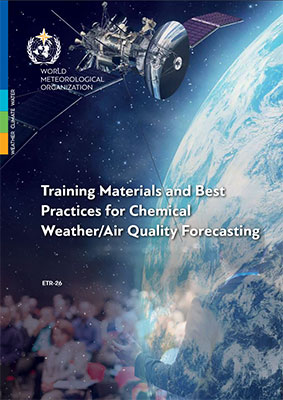
Author: Published by the WMO, this 576-page training book encompasses the combined efforts of 49 coauthors from 15 countries, 35 case providers from 15 countries, and additional 15 reviewers from WMO and other countries. The effort was coordinated by Yang Zhang (CEE Professor and Distinguished Fellow), who served as the book’s lead editor and as a lead author or co-author of twelve of its chapters and sections. – 11/27/2020
Description: This training manual represents a download of knowledge from the world’s leading atmospheric scientists in a concerted effort to strengthen society’s tools for understanding the complex and at times enigmatic science of our atmosphere. That gaseous blanket is a planet-scale puzzle of physics and chemistry, with variables numerous and dynamic: moisture pulled from oceans, dust and heat rising from deserts, radiation from our sun, the seasonal breath-like capture and release of carbon dioxide from forests, chilling currents from the polls, billowing clouds of soot particles from wildfires and volcanoes, and, increasingly important, the ever-growing output of greenhouse gases from humans. |
“Essentials of Civil Engineering Materials”
Authors: Kathryn E. Schulte Grahame (CEE Associate Teaching Professor), Steven W. Cranford, Craig M. Shillaber (CEE Associate Teaching Professor), and Matthew J. Eckelman (CEE Associate Professor) – 12/16/2019
Description: Essentials of Civil Engineering Materials provides students with a foundational guide to the types of materials used in civil engineering, as well as how these materials behave under the conditions for which they were designed and a basic understanding of the science of the materials. This critical knowledge prepares students to carefully consider and confidently select the best materials for the design, construction, and maintenance of future projects.
The text begins by introducing the basic requirements of engineering materials, material properties and standards, experimental design, economic factors, and the issue of sustainability. Additional chapters explore the mechanical principles of materials, composite models and viscoelasticity, and material chemistry. Students read about various types of materials, including metals, steel, aggregates and cementitious materials, and wood. The book concludes with a chapter dedicated to the topic of sustainability. Each chapter includes closing remarks to summarize the key concepts of the chapter and problems to help students retain important learnings. |
“Critical Infrastructures Resilience”
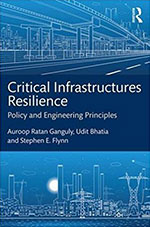
Authors: Auroop Ratan Ganguly (CEE Professor), Stephen E. Flynn (CEE Affiliated Faculty), Udit Bhatia – 3/14/2018
Description: This text offers comprehensive and principled, yet practical, guidelines to critical infrastructures resilience. Extreme events and stresses, including those that may be unprecedented but are no-longer surprising, have disproportionate effects on critical infrastructures, and hence on communities, cities, and megaregions. Critical infrastructures include buildings and bridges, dams, levees, and sea walls, as well as power plants and chemical factories, besides lifeline networks such as multimodal transportation, power grids, communication, and water or waste water. The growing interconnectedness of natural-built-human systems causes cascading infrastructure failures and necessitates simultaneous recovery. This text explores the new paradigm centered on the concept of resilience by approaching the challenges posed by globalization, climate change, and growing urbanization on critical infrastructures and key resources through the combination of policy and engineering perspectives. It identifies solutions that are scientifically credible, data driven, and sound in engineering principles while concurrently informed by and supportive of social and policy imperatives. |
“Sensor Technologies for Civil Infrastructures”
 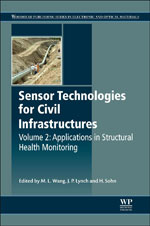 Authors: Ming Wang (COE Distinguished Professor), Jerome P. Lynch, Hoon Sohn – 4/2014, 5/2014
Description: Sensors are used for civil infrastructure performance assessment and health monitoring, and have evolved significantly through developments in materials and methodologies. Sensor Technologies for Civil Infrastructure is a two-volume set that provides an overview of sensor hardware and its use in data collection, analysis, and case studies in assessing and monitoring civil infrastructures. Volume I focuses on sensing hardware and data collection, covering a variety of sensors. The book examines fiber optic systems, acoustic emission, piezoelectric sensors, electromagnetic sensors, ultrasonic methods, and radar and millimeter wave technology. Its chapters cover strain gauges, micro-electro-mechanical systems (MEMS), multifunctional materials and nanotechnology for sensing, and vision-based sensing and lasers. Volume II concentrates on data analysis, with an in-depth examination of sensor data management and analytical techniques for fault detection and localization, looking at prognosis and life-cycle assessment. This volume features case studies in assessing structures such as bridges, buildings, super-tall towers, dams, tunnels, wind turbines, railroad tracks, nuclear power plants, offshore structures, levees, and pipelines. Sensor Technologies for Civil Infrastructure: Volumes I and II provide a standard reference for structural and civil engineers, electronics engineers and academics with an interest in the field. |
“An Introduction to Geotechnical Engineering”
Authors: Robert D. Holtz, Williams D. Kovacs and Thomas Sheahan (CEE Professor and Senior Vice Provost for Curriculum and Programs) – 10/28/10
Description: This book provides a descriptive introduction to geotechnical engineering with applications to civil engineering practices. Focusing on the engineering classification, behavior, and properties of soils necessary for the design and construction of foundations and earth structures, it also includes chapters in Landforms, and the Origin of Geomaterials. |
“Water Centric Sustainable Communities: Planning, Retrofitting and Building the Next Urban Environment”
Authors: Vladimir Novotny (CEE Professor Emeritus), Jack Ahern, and Paul Brown – 10/12/10
Description: This books compartmentalizes the complex issue of water and wastewater into its discrete components: technology, planning policy, construction and economics. The book is the first to capture all of the current work on this idea in a single, integrated, plan for designing water-centric Cities of the Future. From new construction to the retrofitting of existing systems, this book presents the case for a new urban relationship to water, one with a more sustainable connection to the environment. Through case studies of successfully planned and built systems around the world, the book informs the reader about the need for a new approach to urban water management, and makes the case that these changes are not only possible, but imperative. |
“Fundamentals of Structural Analysis”
Author: Kenneth Leet (CEE Professor Emeritus), Chia-Ming Uang, and Anne Gilbert – 9/9/10
Description: This textbook introduces engineering and architecture students to the basic techniques for analyzing the most common structural elements, including beams, frames, cables, and arches. This book covers classical methods of analysis for determinate and indeterminate structures, and provides an introduction to the matrix formulations on which computer analysis is based. This edition features an expanded treatment of snow, earthquake, and wind loads that are part of the updated ANSI/ASCE 7 standards. |
“Water Infrastructure for Sustainable Communities: China and the World”
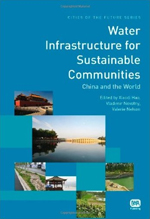 Authors: Xiaodi Hao, Vladimir Novotny (CEE Professor Emeritus), Valerie Nelson – 7/5/10
Description: This text reveals how imaginative concepts are being developed and implemented to ensure that cities, towns, and villages and their water resources can become ecologically sustainable and provide clean water. With both urban and rural waters as a focal point, the links between water quality and hydrology, landscape, and the broader concepts of green cities and smart development are explored. The book focuses on decentralized concepts of potable water, storm water, and wastewater management that would provide clean water. It results in water management systems that would be resilient to extreme events such as excessive flows due to extreme meteorological events, severe droughts, and deteriorated water and urban ecosystem quality. A particular emphasis is placed on learning lessons from the many innovative projects being designed in China and other initiatives around the world. The principal audience for the book is university faculty and students, scientists in research institutes, water professionals, governmental organizations, NGOs, urban landscape architects and planners. |





